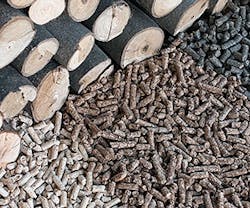Could one of your neighbors be producing the fuel you’ve been looking for?
Locally sourced biomass and biogas are becoming increasingly feasible alternative energy options in many regions. Renewable fuels such as scraps and manufacturing byproducts can be a boon for building owners hoping to further decrease their carbon footprint.
Whether you’re looking to generate your own power on-site or simply hoping to lower your heating-related electricity demand, biofuels may offer an affordable, efficient solution.
Biogas vs. Biomass
Today’s customers have a handful of fuels to choose from, though the ultimate decision will likely be determined by what is available locally.
Biogas fuels are created from the natural breakdown of organic matter. They include methane, hydrogen, and carbon monoxide, which react with oxygen in a controlled environment to release energy.
This fuel source is a better fit for the industrial sector, says to James Olmsted, senior engineer for Antares Group, an energy engineering consultancy. That’s because most commercial and institutional facilities can’t realistically truck in manure or trash to create biogas on-site. However, buildings with nearby resources or certain types of byproducts may be able to benefit.
For example, the Kroger grocery store chain installed an anaerobic conversion system to help power a 650,000-square-foot distribution center in Compton, CA. The converter uses bacteria to break down food scraps and release methane gas, which is then routed to microturbines and boilers to provide heat and steam for an adjacent creamery.
However, biomass is much more common for most buildings, says Olmsted. This utilizes solid organic materials for combustion (as with traditional solid fuels, such as coal) or gasified for use in gas turbines. Using wood waste, such as discarded pallets and scrap lumber, as fuel can even offset the avoided landfill disposal cost, making it possible to collect the waste at a negative cost in some urban areas, the EPA finds.
Why Biofuels?
In addition to the financial benefits, biomass and biogas offer an attractive way to both divert excess waste from landfills and avoid the emissions from relying on conventional coal-fired power plants alone. More than 60% of biomass-powered electricity generation in the U.S. is created by combined heat and power (CHP) systems.
Universities (particularly those in rural areas) are among the ideal customers for biomass CHP systems due to the scope of their needs and tolerance for slower ROI, notes Neeharika Naik-Dhungel, program manager for the EPA’s CHP Partnership Program, a voluntary offering aimed at reducing the environmental impact of electricity production by encouraging CHP development.
However, biomass and biogas can also be attractive options for combustion as well. The University of Iowa, for example, purchases oat hulls from a nearby Quaker Oats plant and co-fires them with coal in a circulating fluidized bed boiler that supplies both heat and power to the university. The oat byproducts cost roughly half as much as the coal they replace and also offer a reliable waste outlet for Quaker.
The UI is currently investigating a landfill gas project that could supply over 90% of the electricity needs for an existing research park.
Key Considerations
As you investigate the cost-effectiveness and green value of adding biofuels to your energy portfolio, ask yourself these questions to determine whether your facility is a good candidate, recommend Naik-Dhungel and Olmsted.
What resources are nearby? Fuel availability is paramount. For instance, wood chips are readily available in the Northeast, Southeast, northern Great Lakes region, and the Pacific Northwest due to the region’s forests and accompanying lumber industry.
Is there space on your property? If you’re opting for CHP, the unit itself will be fairly compact, says Naik-Dhungel: “In commercial applications, the unit is so much smaller than industrial units that people may not even know you have CHP operating.” However, you also need storage silos or bunkers for the raw fuel since you’re not relying on a gas pipeline to feed the unit as you would with a traditional fuel cell.
“For making heat from biomass, solid fuels are challenging because you have to either process the fuel or hold it at the site,” Olmsted explains. “That’s a large factor riding against it. You also need someone who is willing to deal with fuel procurement and champion the project.”
Is your facility ready for a steam turbine? “For biomass, you generally have to go to steam turbine-based technology in order to be commercially ready to go. Other technologies aren’t viable for round-the-clock operation,” says Olmsted. “Steam turbines for combined heat and power in commercial and institutional settings require 400-plus psi of steam entering the turbine to generate a significant amount of electricity, and most facilities use 100 psi or less.”
Janelle Penny [email protected] is senior editor of BUILDINGS.
About the Author
Janelle Penny
Editor-in-Chief at BUILDINGS
Janelle Penny has been with BUILDINGS since 2010. She is a two-time FOLIO: Eddie award winner who aims to deliver practical, actionable content for building owners and facilities professionals.

